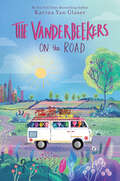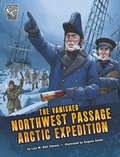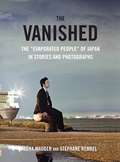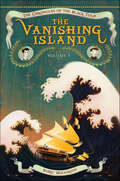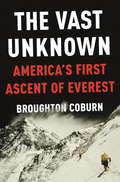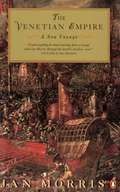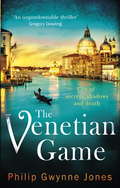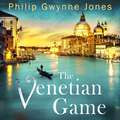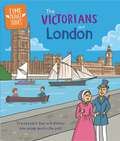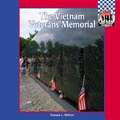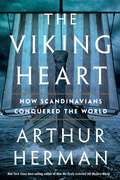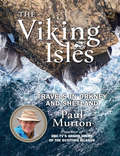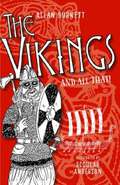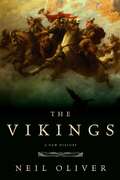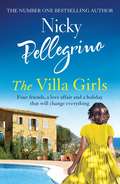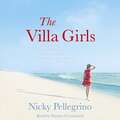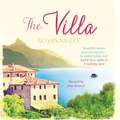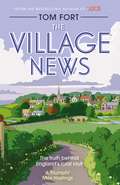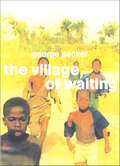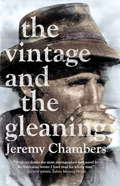- Table View
- List View
The Vanderbeekers on the Road (The Vanderbeekers #6)
by Karina Yan GlaserIn this new adventure in the New York Times bestselling series, the Vanderbeekers depart Harlem to celebrate their dad's birthday. But their surprise road trip turns rocky when the younger kids try to keep their family from ever facing change.Our beloved Harlem family is putting the VAN in Vanderbeekers as they hit the highway to give their dad the best birthday surprise EVER! Re-creating a road trip Papa never got the chance to take with his own father, the whole crew is packed and ready for a cross-country adventure.Things get off to a rocky start when the car breaks down on their way to pick up Papa. But they really veer off course when Laney discovers that Jessie and Orlando are interviewing at a college once they get to California. How can they even think about leaving New York? Wouldn't that change their family? And how can she and her other siblings stop them?Exploring themes of leaving home, embracing change, and the lessons to be learned when we go to a new place, The Vanderbeekers on the Road is every bit a journey.The New York Times bestselling Vanderbeekers series is perfect for fans of the Penderwicks. As Booklist commented in a starred review: “Few families in children’s literature are as engaging or amusing as the Vanderbeekers, even in times of turmoil.”The series includes:The Vanderbeekers of 141st StreetThe Vanderbeekers and the Hidden GardenThe Vanderbeekers to the RescueThe Vanderbeekers Lost and FoundThe Vanderbeekers Make a WishThe Vanderbeekers on the Road
The Vanished Northwest Passage Arctic Expedition (Deadly Expeditions)
by Lisa M. SimonsIn 1845, Sir John Franklin commanded two ships on an expedition to find a Northwest Passage from England through the Arctic and over to Asia. If successful, the route would be a faster way to get goods from Asia to Europe and back. But success was not in the cards for Franklin’s expedition. Only recently, the sunken ships were discovered in the icy Arctic waters. What happened to Franklin and his men, and what messages did they leave behind?
The Vanished: The "Evaporated People" of Japan in Stories and Photographs
by Léna Mauger Stéphane RemaelEvery year, nearly one hundred thousand Japanese vanish without a trace. Known as the johatsu, or the "evaporated,” they are often driven by shame and hopelessness, leaving behind lost jobs, disappointed families, and mounting debts. In The Vanished, journalist Léna Mauger and photographer Stéphane Remael uncover the human faces behind the phenomenon through reportage, photographs, and interviews with those who left, those who stayed behind, and those who help orchestrate the disappearances. Their quest to learn the stories of the johatsu weaves its way through: A Tokyo neighborhood so notorious for its petty criminal activities that it was literally erased from the maps Reprogramming camps for subpar bureaucrats and businessmen to become "better” employees The charmless citadel of Toyota City, with its iron grip on its employees The "suicide” cliffs of Tojinbo, patrolled by a man fighting to save the desperate The desolation of Fukushima in the aftermath of the tsunamiAnd yet, as exotic and foreign as their stories might appear to an outsider’s eyes, the human experience shared by the interviewees remains powerfully universal.
The Vanishing Island (Chronicles of the Black Tulip #1)
by Barry WolvertonAn engrossing fantasy, a high-seas adventure, an alternate history epic—this is the richly imagined and gorgeously realized new book from acclaimed author Barry Wolverton, perfect for fans of The Glass Sentence and the Books of Beginning series.It's 1599, the Age of Discovery in Europe. But for Bren Owen, growing up in the small town of Map on the coast of Britannia has meant anything but adventure. Enticed by the tales sailors have brought through Map's port, and inspired by the arcane maps his father creates as a cartographer for the cruel and charismatic map mogul named Rand McNally, Bren is convinced that fame and fortune await him elsewhere.That's when Bren meets a dying sailor, who gives him a strange gift that hides a hidden message. Cracking the code could lead Bren to a fabled lost treasure that could change his life forever, and that of his widowed father. Before long, Bren is in greater danger than he ever imagined and will need the help of an unusual friend named Mouse to survive.
The Vast Unknown
by Broughton CoburnBy the author of the New York Times bestselling Everest: Mountain Without Mercy, this chronicle of the iconic first American expedition to Mt. Everest in May 1963 - published to coincide with the climb's 50th anniversary - combines riveting adventure, a perceptive analysis of its dark and terrifying historical context, and revelations about a secret mission that followed. In the midst of the Cold War, against the backdrop of the Bay of Pigs fiasco, the space race with the Soviet Union, and the quagmire of the Vietnam War, a band of iconoclastic, independent-minded American mountaineers set off for Mt. Everest, aiming to restore America's confidence and optimism. Their objective is to reach the summit while conducting scientific research, but which route will they take? Might the Chinese, in a public relations coup, have reached the top ahead of them? And what about another American team, led by the grandson of a President, that nearly bagged the peak in a bootleg attempt a year earlier? The Vast Unknown is, on one level, a harrowing, character-driven account of the climb itself and its legendary team of alternately inspiring, troubled, and tragic climbers who suffered injuries, a near mutiny, and death on the mountain. It is also an examination of the profound sway the expedition had over the American consciousness and sense of identity during a time when the country was floundering. And it is an investigation of the expedition's little-known outcome: the selection of a team to plant a CIA surveillance device on the Himalayan peak of Nanda Devi, to spy into China where Defense Intelligence learned that nuclear missile testing was underway.From the Hardcover edition.
The Venetian Empire: A Sea Voyage
by Jan MorrisFor six centuries the Republic of Venice was a maritime empire, its sovereign power extending throughout much of the eastern Mediterranean – an empire of coasts, islands and isolated fortresses by which, as Wordsworth wrote, the mercantile Venetians 'held the gorgeous east in fee'. Jan Morris reconstructs the whole of this glittering dominion in the form of a sea-voyage, travelling along the historic Venetian trade routes from Venice itself to Greece, Crete and Cyprus. It is a traveller's book, geographically arranged but wandering at will from the past to the present, evoking not only contemporary landscapes and sensations but also the characters, the emotions and the tumultuous events of the past. The first such work ever written about the Venetian ‘Stato da Mar’, it is an invaluable historical companion for visitors to Venice itself and for travellers through the lands the Doges once ruled.
The Venetian Game: a haunting thriller set in the heart of Italy's most secretive city
by Philip Gwynne Jones'An unputdownable thriller' Gregory Dowling'It is no surprise to find that Philip Gwynne Jones lives in Venice... art and architecture interweave into a story that builds to an almost surreal climax' Daily Mail*****A game of cross and double-cross in Venice, one of the most beautiful cities on earth.From his office on the Street of the Assassins, Nathan Sutherland enjoys a steady but unexciting life translating Italian DIY manuals. All this changes dramatically when he is offered a large sum of money to look after a small package containing an extremely valuable antique prayer book illustrated by a Venetian master. But is it a stolen masterpiece - or a brilliant fake?Unknown to Nathan, from a vast mansion on the Grand Canal twin brothers Domenico and Arcangelo Moro, motivated by nothing more than mutual hatred, have been playing out a complex game of art theft for twenty years. And now Nathan finds himself unwittingly drawn into their deadly business . . .*****Praise for Philip Gwynne Jones'Superb - always gripping, beautifully constructed and vivid' Stephen Glover'Sinister and shimmering, The Venetian Game is as haunting and darkly elegant as Venice itself' L.S. Hilton, bestselling author of Maestra'Clever and great fun' The Times'The Venetian setting is vividly described... good, fluid writing makes for easy reading' Literary Review'Un-put-downable . . . If you love Venice, you'll love this because you'll be transported there in an instant. If you've not been to Venice, read this book and then go. If you like intrigue, and a clever plot, you'll love this book' Amazon reviewer, 5**********Vengeance in Venice, the second book in Philip Gwynne Jones' sensational Venice series, is available now
The Venetian Game: a haunting thriller set in the heart of Italy's most secretive city
by Philip Gwynne Jones'An unputdownable thriller' Gregory Dowling'It is no surprise to find that Philip Gwynne Jones lives in Venice... art and architecture interweave into a story that builds to an almost surreal climax' Daily Mail*****A game of cross and double-cross in Venice, one of the most beautiful cities on earth.From his office on the Street of the Assassins, Nathan Sutherland enjoys a steady but unexciting life translating Italian DIY manuals. All this changes dramatically when he is offered a large sum of money to look after a small package containing an extremely valuable antique prayer book illustrated by a Venetian master. But is it a stolen masterpiece - or a brilliant fake?Unknown to Nathan, from a vast mansion on the Grand Canal twin brothers Domenico and Arcangelo Moro, motivated by nothing more than mutual hatred, have been playing out a complex game of art theft for twenty years. And now Nathan finds himself unwittingly drawn into their deadly business . . .*****Praise for Philip Gwynne Jones'Superb - always gripping, beautifully constructed and vivid' Stephen Glover'Sinister and shimmering, The Venetian Game is as haunting and darkly elegant as Venice itself' L.S. Hilton, bestselling author of Maestra'Clever and great fun' The Times'The Venetian setting is vividly described... good, fluid writing makes for easy reading' Literary Review'Un-put-downable . . . If you love Venice, you'll love this because you'll be transported there in an instant. If you've not been to Venice, read this book and then go. If you like intrigue, and a clever plot, you'll love this book' Amazon reviewer, 5**********Vengeance in Venice, the second book in Philip Gwynne Jones' sensational Venice series, is available now
The Victorians and London (Time Travel Guides #7)
by Tim CookeStep back in time to discover life in London during the reign of Queen Victoria with this handy time travel guidebookTravel back in time to Victorian London and find out all about life and culture there. Get ready to visit a cotton mill, drink coffee in one of new coffee houses and watch the Changing of the Guard at Buckingham Palace! Like modern travel guides, the books in this series highlight must-see features and explain local culture. Each highlighted destination contains an explanation of what took part in these areas, as well as a look at important artefacts found there providing a bigger picture of life in the past. Typical travel guide notes include, 'best time to visit', 'what to eat' and 'where to stay'. Perfect for the KS2 history curriculum, and for readers aged 7 and up.Contents:LondonPutting London on the mapOut and aboutVictorian homesChristmasThe East EndStroll along the riverVictorian childrenHealth and medicineBooming BritainTime offBuckingham PalaceVisit quick!GlossaryFurther informationIndexBooks in this series:The Maya and Chichén Itza Roman Britain and LondiniumThe Stone Age and Skara BraeViking Britain and JorvikThe Ancient Greeks and AthensThe Shang Dynasty and YinThe Victorians and London The Ancient Egyptians and Thebes
The Vietnam Veterans Memorial
by Tamara L. BrittonProvides background information on the Vietnam War and on the memorial that was built to honor those who died during this conflict.
The View From Serendip
by Arthur C. ClarkeThis book includes many articles on the personal universe of Arthur C. Clarke, including life at home on his island paradise, in ancient times called Serendip, then Ceylon, now Sri Lanka, his continuing involmement with space travel from the earliest days as a member of the British interplanetary Society to his coverage of the Apollo moon shots for CBS television, to the world of 2001 ... or what's in store for us in the nest 20 years, and more
The Viking Heart: How Scandinavians Conquered the World
by Arthur Herman&“A stirring investigation of the Scandinavian influence on our times, both past and present. You won&’t look at the world the same way again.&”—Neal Bascomb, New York Times best-selling author of The Winter FortressFrom a New York Times best-selling historian and Pulitzer Prize finalist, a sweeping epic of how the Vikings and their descendants have shaped history and America Scandinavia has always been a world apart. For millennia Norwegians, Danes, Finns, and Swedes lived a remote and rugged existence among the fjords and peaks of the land of the midnight sun. But when they finally left their homeland in search of opportunity, these wanderers—including the most famous, the Vikings—would reshape Europe and beyond. Their ingenuity, daring, resiliency, and loyalty to family and community would propel them to the gates of Rome, the steppes of Russia, the courts of Constantinople, and the castles of England and Ireland. But nowhere would they leave a deeper mark than across the Atlantic, where the Vikings&’ legacy would become the American Dream.In The Viking Heart, Arthur Herman melds a compelling historical narrative with cutting-edge archaeological and DNA research to trace the epic story of this remarkable and diverse people. He shows how the Scandinavian experience has universal meaning, and how we can still be inspired by their indomitable spirit.
The Viking Isles: Travels in Orkney and Shetland
by Paul MurtonThe BBC travel personality explores the Nordic legacy of these remote Scottish islands: &“Engagingly written and superbly illustrated.&” —Undiscovered Scotland Paul Murton has long had a love of the Viking north—the island groups of Orkney and Shetland and the old counties of Caithness and Sutherland—which, for centuries, were part of the Nordic world as depicted in the great classic known as the Orkneyinga Saga. Today this fascinating Scandinavian legacy can be found everywhere—in physical remains, place names, local traditions and folklore, and much else. This is a personal account of Paul Murton&’s travels in the Viking north. Full of observation, history, anecdote, and encounters with those who live there, it also serves as a practical guide to the many places of interest. From a sing-along with the Shanty Yell Boys to fishing off Muckle Flugga, from sword dancing with the men of Papa Stour to a Norwegian pub crawl in Lerwick, this book paints a vivid picture of these lands and their people, and explores their extraordinary rich heritage.
The Vikings and All That (The And All That Series)
by Allan BurnettThe history of these pillaging, plundering, board-game-playing Scandinavian seafaring warriors, in lively words and pictures!The Vikings and All That is a skull-splitting saga about the wild, seafaring warriors who burst into history in the eighth century and looted, plundered, pillaged, and burned their way from their native Scandinavia to the British Isles and much of Europe. Packed with fantastic, fun illustrations of everything from the Vikings&’ warships to their favorite board games, this is the book that answers all the key questions you might have. If you want sensible answers, packed with historical facts and thoughtful revelations about the Vikings&’ civilized side then this is the book for you. But if you want boatloads of bearded, shield-biting maniacs bearing down on defenseless, sandal-wearing villagers, then this is definitely the book for you!
The Vikings: A New History
by Niel OliverThe Vikings famously took no prisoners, relished cruel retribution, and prided themselves on their bloodthirsty skills as warriors. But their prowess in battle is only a small part of their story, which stretches from their Scandinavian origins to America in the west and as far as Baghdad in the east. As the Vikings did not write their own history, we have to discover it for ourselves, and that discovery, as Neil Oliver reveals, tells an extraordinary story of a people who, from the brink of destruction, reached a quarter of the way around the globe and built an empire that lasted nearly two hundred years. Drawing on the latest discoveries that have only recently come to light, Scottish archaeologist Neil Oliver goes on the trail of the real Vikings. Where did they emerge from? How did they really live? And just what drove them to embark on such extraordinary voyages of discovery over 1,000 years ago? The Vikings explores many of those questions for the first time in an epic story of one of the world's great empires of conquest.
The Villa Girls
by Nicky PellegrinoFour friends, a sun-drenched escape, and a holiday that will change everything...THE VILLA GIRLS is the story of four young women who decide that wherever they are in the world and whatever they're doing they'll meet every few years for a holiday together somewhere sunny. Despite life taking them in very different directions, their snatched days in the sun in little hidden villas are crucial to them all. Escape, celebration, recovery - over the years the holidays change their lives.Rosie was always the odd one out - initially only invited as the others felt sorry for her, but it seems that in the end, she might be the one whose life is touched the most by her villa days. For it's there that she meets Enzo. The eldest son of an olive oil dynasty in southern Italy, he is being groomed to take over one day as head of the family.Rosie and Enzo have a holiday romance that seems set to become something more serious until she discovers he is not entirely what he seems. Years later they meet again and this time Rosie must decide how much she is prepared to compromise for the sake of love...
The Villa Girls
by Nicky PellegrinoTHE VILLA GIRLS is the story of four young women who decide that wherever they are in the world and whatever they're doing they'll meet every few years for a holiday together somewhere sunny. Despite life taking them in very different directions, their snatched days in the sun in little hidden villas are crucial to them all. Escape, celebration, recovery - over the years the holidays change their lives.Rosie was always the odd one out - initially only invited as the others felt sorry for her, but it seems that in the end, she might be the one whose life is touched the most by her villa days. For it's there that she meets Enzo. The eldest son of an olive oil dynasty in southern Italy, he is being groomed to take over one day as head of the family.Rosie and Enzo have a holiday romance that seems set to become something more serious until she discovers he is not entirely what he seems. Years later they meet again and this time Rosie must decide how much she is prepared to compromise for the sake of love...Read by Harriet Carmichael(p) 2015 Orion Publishing Group
The Villa: Escape to Sicily with the Number One Bestseller
by Rosanna LeyTHE #1 KINDLE BESTSELLER. An unforgettable story set off the sun-soaked coast of Sicily for fans of Dinah Jefferies, Victoria Hislop and Santa Montefiore.'The perfect holiday companion' - Heat'The ultimate feel-good read' - Candis'Sun-soaked escapism' - Best**********When Tess Angel receives a solicitor's letter inviting her to claim her inheritance - the Villa Sirena, perched on a clifftop in Sicily - she is stunned. Her only link to the island is through her mother, Flavia, who left Sicily during World War II and cut all contact with her family. When Tess goes to Sicily, Flavia realises the secrets from her past are about to be revealed and decides to try to explain her actions. Meanwhile, Tess' teenage daughter Ginny is stressed by college, by her blooming sexuality and filled with questions that she longs to ask her father, if only she knew where he was...********SEE WHAT EVERYONE IS SAYING ABOUT ROSANNA LEY:'An impeccably researched and deftly written narrative that kept me hooked until the end' - Kathryn Hughes, bestselling author of The Letter 'Loved it from start to finish. A brilliant holiday read' - Amazon reviewer'Perfect for fans of Santa Montefiore, Victoria Hislop and Leah Fleming' - Candis 'On so many levels a fantastic read' - Amazon reviewer'A fascinating story with engaging themes' - Dinah Jefferies, bestselling author of The Tea Planter's Wife 'Warm, enthralling, one of my favourite authors' - Amazon reviewer
The Villa: Escape to Sicily with the Number One Bestseller
by Rosanna LeyTHE #1 KINDLE BESTSELLER. An unforgettable story set off the sun-soaked coast of Sicily for fans of Dinah Jefferies, Victoria Hislop and Santa Montefiore.'The perfect holiday companion' - Heat'The ultimate feel-good read' - Candis'Sun-soaked escapism' - Best**********When Tess Angel receives a solicitor's letter inviting her to claim her inheritance - the Villa Sirena, perched on a clifftop in Sicily - she is stunned. Her only link to the island is through her mother, Flavia, who left Sicily during World War II and cut all contact with her family. When Tess goes to Sicily, Flavia realises the secrets from her past are about to be revealed and decides to try to explain her actions. Meanwhile, Tess' teenage daughter Ginny is stressed by college, by her blooming sexuality and filled with questions that she longs to ask her father, if only she knew where he was...********SEE WHAT EVERYONE IS SAYING ABOUT ROSANNA LEY:'An impeccably researched and deftly written narrative that kept me hooked until the end' - Kathryn Hughes, bestselling author of The Letter 'Loved it from start to finish. A brilliant holiday read' - Amazon reviewer'Perfect for fans of Santa Montefiore, Victoria Hislop and Leah Fleming' - Candis 'On so many levels a fantastic read' - Amazon reviewer'A fascinating story with engaging themes' - Dinah Jefferies, bestselling author of The Tea Planter's Wife 'Warm, enthralling, one of my favourite authors' - Amazon reviewer
The Villa: Escape to Sicily with the Number One Bestseller
by Rosanna LeyTHE #1 KINDLE BESTSELLER. An unforgettable story set off the sun-soaked coast of Sicily for fans of Dinah Jefferies, Victoria Hislop and Santa Montefiore.'The perfect holiday companion' - Heat'The ultimate feel-good read' - Candis'Sun-soaked escapism' - Best**********When Tess Angel receives a solicitor's letter inviting her to claim her inheritance - the Villa Sirena, perched on a clifftop in Sicily - she is stunned. Her only link to the island is through her mother, Flavia, who left Sicily during World War II and cut all contact with her family. When Tess goes to Sicily, Flavia realises the secrets from her past are about to be revealed and decides to try to explain her actions. Meanwhile, Tess' teenage daughter Ginny is stressed by college, by her blooming sexuality and filled with questions that she longs to ask her father, if only she knew where he was...********SEE WHAT EVERYONE IS SAYING ABOUT ROSANNA LEY:'An impeccably researched and deftly written narrative that kept me hooked until the end' - Kathryn Hughes, bestselling author of The Letter'Loved it from start to finish. A brilliant holiday read' - Amazon reviewer'Perfectfor fans of Santa Montefiore, Victoria Hislop and Leah Fleming' - Candis'On so many levels a fantastic read' - Amazon reviewer'A fascinating story with engaging themes' - Dinah Jefferies, bestselling author of The Tea Planter's Wife 'Warm, enthralling, one of my favourite authors' - Amazon reviewer
The Villa: Escape to Sicily with the Number One Bestseller
by Rosanna LeySet against the rugged coast of Sicily, debut novelist Rosanna Ley creates a lush multi-generational story in The Villa; an epic journey of love lost, family secrets, the road to self-discovery and the meaning of home and family. When Tess Angel receives a letter informing her she has inherited the Villa Sirena, perched on a clifftop in Sicily--she is stunned. Her only link to the small beautiful island is through her mother, Flavia, who left Sicily during World War II and has not spoken to her family, or of her life there, since. Initially resistant to Tess traveling to her home country, Flavia begins to recount her youth, told in flashbacks as she writes in a journal to Tess of her journey to independence, as well as leaving her legacy of cherished family recipes and secrets. Secrets including a lost treasure rumored to be hidden in the very Villa Tess is staying at. Told in alternating points-of-view between Tess, Flavia, and Tess' teenage daughter Ginny, dealing with her blooming sexuality and filled with questions that she longs to ask her long-absent father.(P)2014 WF Howes Ltd
The Village Against The World
by Dan HancoxThe land is for those who work it--"La tierra es de quien la trabaja."One hundred kilometers from Seville, there is a small village, Marinaleda, that for the last thirty years has been at the center of a long struggle to create a communist utopia. In a story reminiscent of the Asterix books, Dan Hancox explores the reality behind the community where no one has a mortgage, sport is played in the Che Guevara stadium and there are monthly "Red Sundays" where everyone works together to clean up the neighbourhood. In particular he tells the story of the village mayor, Sánchez Gordillo, who in 2012 became a household name in Spain after leading raids on local supermarkets to feed the Andalucian unemployed.
The Village News: The Truth Behind England's Rural Idyll
by Tom FortWe have lived in villages a long time. The village was the first model for communal living. Towns came much later, then cities. Later still came suburbs, neighbourhoods, townships, communes, kibbutzes. But the village has endured. Across England, modernity creeps up to the boundaries of many, breaking the connection the village has with the land. With others, they can be as quiet as the graveyard as their housing is bought up by city ‘weekenders’, or commuters. The ideal chocolate box image many holidaying to our Sceptred Isle have in their minds eye may be true in some cases, but across the country the heartbeat of the real English village is still beating strongly – if you can find it. To this mission our intrepid historian and travel writer Tom Fort willingly gets on his trusty bicycle and covers the length and breadth of England to discover the essence of village life. His journeys will travel over six thousand years of communal existence for the peoples that eventually became the English. Littered between the historical analysis, will be personal memories from Tom of the village life he remembers and enjoys today in rural Oxfordshire.
The Village of Waiting
by George PackerNow restored to print with a new Foreword by Philip Gourevitch and an Afterword by the author, The Village of Waiting is a frank, moving, and vivid account of contemporary life in West Africa. Stationed as a Peace Corps instructor in the village of Lavié (the name means "wait a little more") in tiny and underdeveloped Togo, George Packer reveals his own schooling at the hands of an unforgettable array of townspeople--peasants, chiefs, charlatans, children, market women, cripples, crazies, and those who, having lost or given up much of their traditional identity and fastened their hopes on "development," find themselves trapped between the familiar repetitions of rural life and the chafing monotony of waiting for change.
The Vintage and the Gleaning
by Jeremy ChambersSmithy is a retired shearer turned vineyard worker in his autumn years. It is hard graft, but Smithy has always worked with his hands. Physically all but destroyed after a lifetime of hard liquor, but now sober, he begins to see the world with new eyes, a meditative, singular figure in the town's bar on rowdy Friday nights. But clarity can be a curse. Finally confronting his past, overwhelmed by long-buried feelings of regret, nostalgia and loss, Smithy steps in to help a young woman in a desperate situation. A cautious friendship develops, but Charlotte's husband is widely suspected of murder, and Smithy begins to fear that he will pay a high price for his gallantry. Written with an authentic music, and infused with beauty, brutality and sadness The Vintage and the Gleaning is a compelling observation of men, women and country. A remarkably accomplished debut novel.
